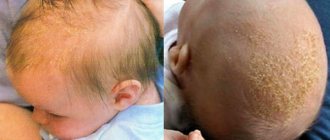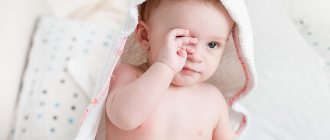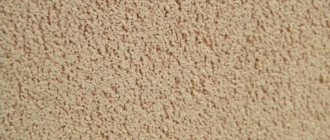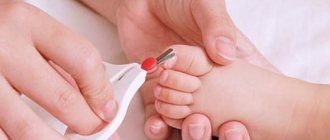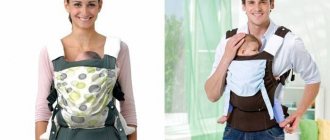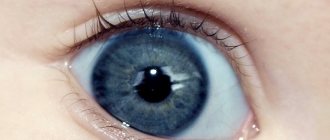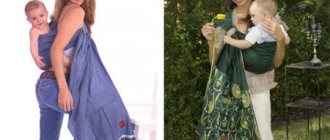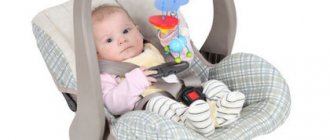Having a child brings new responsibilities for parents. Returning from the maternity hospital marks a new stage in the life of the family, and young parents are faced with many questions. One of them is how to properly wash a newborn. It is not clear what the water in the bath should be like, whether something needs to be added to it, or whether soap can be used. The answers to these questions are not so much difficult as they are important.
Is it possible to wash a newborn with soap?
A baby's skin is very delicate, so you need to be extremely careful with soap. Even if a bar of soap is labeled “baby”, pediatricians do not recommend using it in the first weeks of life.
Is it possible to wash a newborn with soap? It is possible, but not often. During the first week after returning from the maternity hospital, you do not need to use soap at all when bathing. In the future, you can soap the baby’s body no more than once or twice a week.
But by and large, until the child begins to crawl, there is simply nowhere for him to get dirty, which means that it is the parents who feel the need to use soap rather than the baby himself. Sweat glands on a baby's body work differently than on the body of an adult or grown-up child. Therefore, a simple wash with water is sufficient for the baby.
As for washing , you can and even need to use baby soap after stool. After washing, the butt and legs should be thoroughly blotted with a thick terry towel, and the skin should be lubricated with fragrance-free baby cream.
Is it possible to wash a newborn with liquid soap, not bar soap, or, for example, cream soap? The answer is the same. It is possible, but only if the baby is really dirty. During daily “ritual” bathing there is no point in using soap. Moreover, frequent washing with soap can harm not only the baby’s skin, but also his health.
List of things for bathing a newborn
18.01.2011 On the day of arrival from the maternity hospital, if there are no corresponding contraindications, doctors recommend giving the baby a bath. What items do you need to have ready to successfully produce your first children's toilet?
For bathing and subsequent treatment of the baby’s body you will need
:
▪ an enamel or plastic bath (under no circumstances use it for other purposes!);
▪ in the first days of the baby’s life, bathing water must be boiled or disinfected with a weak solution of pale pink potassium permanganate. As the umbilical wound heals, a solution of chamomile, sage, and calendula can be used for the same purposes;
▪ room thermometer (the optimal air temperature for bathing a child is 23°-27°C);
▪ thermometer for measuring water temperature (the temperature of water prepared for swimming should not exceed 37°-37.5°C);
▪ a special stand for the bath or a mattress placed on the bottom;
▪ terry mitten or soft sponge (optional);
▪ special children's gel-foam for bathing or baby soap;
▪ plastic jug (water for dousing must be prepared in advance, before bathing);
▪ soft terry towel with a “corner”;
▪ a set of clean, dry and warm (in winter) underwear: a cap or scarf made of cotton fabric, a thin vest, a flannel vest, rompers, socks, “scratchies.”
▪ a box with sterile cotton wool;
▪ cotton swabs for cleaning ears;
▪ baby talc or a special product for treating the skin of infants based on zinc;
▪ baby cream or hygienic oil (you can use sterilized vegetable oil or vaseline oil);
▪ small scissors with rounded ends for cutting nails;
▪ hair brush (soft bristles).
If the process is properly organized, the baby will very soon love splashing around in warm water. Enjoy your bath!
| Also on topic |
| 01/06/2011 Bathing “according to the rules” Often, young mothers, while still in the maternity hospital, ask the question: how to bathe a child correctly? What is the optimal water and air temperature? What products are best to add to water? How often should water procedures be carried out? You will find answers to these and other questions in our article. |
| 12/15/2010 Subtleties of caring for a baby Every morning, a baby, just like an adult, needs hygiene procedures: he should wash his face, wash his hands, wash his genitals. It happens that just washing is not enough - you need to clean your nose or ears, and do some wellness procedures. Read our article about how this is done, as well as about other features of caring for a child under one year old. |
| 07/18/2011 Baby skin care for allergies Unfortunately, allergic diathesis today is a very common phenomenon. How to care for the skin of a baby prone to this unpleasant condition? We will talk about this and much more in our article. |
| Our forum for parents |
| The best way to discuss any issue related to family, health, expecting a child or raising a child, or simply chat with other parents is on our forum for moms and dads! Welcome! |
Why you shouldn't overuse soap
Any soap, even one specially created for the delicate skin of infants, contains drying agents. It dissolves a special fatty film on infant skin, that is, it deprives it of its natural protection. Therefore, parents should not get carried away with excessive cleanliness. But you definitely need to know what kind of soap is best to wash a newborn.
What are the risks of using soap too much when bathing a baby?
• deprived of a protective film, the epidermis (outer layer of skin) is subject to increased attack by bacteria and viruses. It takes approximately two days to restore protection, and this time is potentially dangerous;
• after washing with soap, the skin begins to actively absorb substances, including those that are removed from the body as toxins. On the other hand, soap disrupts excretory functions. Accordingly, through the skin the body seems to poison itself;
• drying agents contained in soap negatively affect the condition of the skin and can cause itching and irritation. That is why after using soap you need to treat your skin with baby cream;
• if the soap contains synthetic substances, it will clearly not bring health to children’s skin and in general can seriously affect their health;
• Flavorings work in the same way. If a bar of soap has a strong smell or is brightly colored, it is clearly not suitable for babies, no matter how the manufacturer labels their product.
Frequent use of soap is undesirable and even harmful. One or maximum two washes a week will not cause harm. You cannot bathe with soap every day.
Common questions from parents
Where to place the baby bath?
Hygiene procedures can be carried out in any room. The main thing is that the ambient temperature is not lower than 24 degrees, without excess dampness and drafts.
How often should you bathe your baby?
From the first days, you need to bathe your newborn every day. This is useful not only from a physiological point of view (water procedures improve metabolism, normalize muscle tone, and maintain healthy skin), but also have a beneficial effect on the emotional state.
When can you start bathing in a large bathtub?
Many parents want to transfer their baby to a shared bath as soon as possible. Pediatrician Evgeniy Komarovsky’s system even assumes that the baby can swim and dive from birth! But such experiments should not be started before two months of age. It would be useful to remind you about hygiene: the bathtub must first be thoroughly cleaned and disinfected.
How to bathe a newborn without assistance?
If a young mother has to cope with the baby on her own, then it is better to purchase a special bath chair or hammock. This device gently secures the child in a comfortable position and reduces the risk of injury.
What soap is best to wash a newborn?
You can't do without soap at all. If only because the baby soils the diapers 5 to 8 times a day. What soap is best to wash a newborn so as not to harm his body? Here are the basic rules that will help parents choose the best for their baby:
• You should immediately refuse to buy No Name soap. Large, reliable manufacturers have introduced a strict quality system and use natural and safe ingredients;
• When purchasing a product, pay attention to the “neutral PH” and “clinical testing” marks. This means that the soap has been tested and will not harm the baby’s skin;
• good baby soap should not contain any fragrances, dyes, or synthetic components;
• if the soap contains herbs, this is not always good. The fact is that they can cause allergies, irritation, and dryness.
It is necessary to take into account the individual characteristics of the child. It is impossible to say unequivocally which soap is best to wash a newborn. In some children, the skin reacts well to herbal extracts (chamomile, celandine, chamomile), while in others the plants cause allergies.
Therefore, before you soap your beloved child, check whether the soap will cause a negative reaction. The test is very simple: apply soap to the crook of your elbow or wrist, rinse and observe the skin. If after two or three days nothing bad has happened to the skin, it remains clean, without redness, you can use this soap.
How to properly wash a newborn
After each bowel movement, the child needs to be washed. The procedure is slightly different for boys and girls. This is due to the structure of the genital organs.
The newborn girl is washed under running water with hand movements towards the anus to prevent dirt and inflammation from entering.
Soap is used as a last resort. The fact is that the skin of the mucous membranes on the girl’s genitals is very delicate, and soap injures it and causes inflammation. This, in turn, is fraught with fusion of the labia minora (synechia). When washing, it is more correct to hold the girl on her back, laying her on her elbow and holding her by the handle.
It is more convenient to wash a newborn boy the other way around: laying him on his elbow with his tummy. You need to wash the baby under running warm water, first the bottom, then the genitals. Caring for baby boys is easier.
How to prepare a bath
Bathing a baby every day is a ritual that should be enjoyable for both baby and mother. Therefore, details are important: the temperature of the water and air, a “hill” for convenience, a soft diaper spread on the bottom of the bath.
The meaning of the procedure is not so much to wash away the dirt, but to ensure that the child relaxes, feels the pleasant warmth of the water, the touch of the mother’s hands and a fluffy towel. In addition, daily bathing is a hardening procedure. The combination of water and air, temperature changes make the immune system work and strengthen it.
You can bathe your newborn one day after the first BCG vaccination. However, there is no need for this, so nothing bad will happen if the mother postpones the procedure for a few days. The duration of the first bath is 2-3 minutes. After a week, the baby can be left in the water for five minutes, gradually increasing the procedure to 10-15 minutes.
How to properly wash a newborn in the bath? First of all, prepare the water. During the first month of life, some pediatricians recommend boiling it to avoid inflammation of the umbilical wound. For disinfection (especially if unboiled water is used), manganese can be added, achieving a slight pinkish color.
The water temperature should not be higher than 37 degrees, and the air temperature should not be lower than 22 degrees. It is important that the child does not freeze, but swimming in hot water will not bring him joy. If there is no special water thermometer, mother can easily check the temperature by immersing her elbow in the prepared bath. The skin should not feel either cold or heat.
Whether to add decoctions of medicinal herbs to the water depends on the wishes of the parents. There is no particular need for them if the child’s skin is healthy. Moreover, the newborn may develop allergies. If this happens, then the experiments must be stopped immediately. It’s another matter if the doctor prescribes a decoction of this or that herb for medicinal purposes (for example, for prickly heat, dermatitis, etc.). In this case, you need to follow the pediatrician's recommendations.
Preparing for a shared bath
A large bathtub fills with water at a comfortable temperature. This is 36-37 degrees – body temperature. Some babies like the water a degree or two colder, while mothers prefer it warmer. It is advisable to leave the tap open with a continuously flowing small stream; the drain hole also does not close completely. This will maintain water recirculation and its constant temperature.
A rubber non-slip mat is placed on the bottom of the bath. At the head of the bed, under my shoulders, I place Alisa’s foam bathing mat. This makes bathing more comfortable and relaxing. The water level is approximately halfway through the bath bowl.
You can add a handful of sea salt to the water (its trace elements have a general strengthening effect), a little solution of pine extract (for restless children) or a cup of starch (the skin will become like silk).
Discuss the use of herbs with your pediatrician, because... they often dry out the skin and can provoke an allergic reaction.
Foam for bathing should be pH-neutral and preferably enriched with moisturizing components, since the alkali of the soap “steals” fats from the baby’s skin, which is rich in them. The best washcloth is a natural sea sponge. I use a terry cloth.
The child is placed in a chaise longue or other carrier installed on the bathroom floor. I use an infant carrier with a towel placed at the bottom.
The mother climbs into the bathtub and takes the baby out of the carrier. With his free hand he takes off the diaper and throws it into the basket. It’s easier when dad can give the baby to mom.
You can use swim diapers to protect the water from little surprises. These diapers are reusable and look like thick swim panties with a terry lining. Mom doesn't have to wear a swimsuit. Water disinfectant tablets are also not needed. The microflora of a mother and her child are similar. Of course, you should not start swimming if you have contagious skin diseases.

